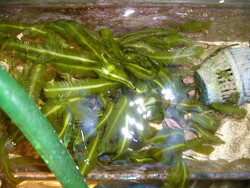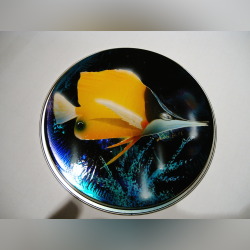Info
Caulerpa taxifolia (M.Vahl) C.Agardh, 1817
Caulerpa is a genus of seaweeds in the family Caulerpaceae (among the green algae). They are unusual because they consist of only one cell with many nuclei, making them among the biggest single cells in the world. A species in the Mediterranean can have a stolon more than 3 m long, with up to 200 fronds. This species can be invasive from time to time.
Referring to its thalli's crawling habit, the name means 'stem (that) creeps', from the Ancient Greek kaulos ( ‘stalk’) and herpo (‘to creep’).
Synonymised names:
Caulerpa pennata J.V.Lamouroux, 1809
Caulerpa taxifolia f. typica Svedelius, 1906 (synonym)
Fucus taxifolius M.Vahl, 1802
Direct children (7):
Forma Caulerpa taxifolia f. asplenoides (Greville) Weber Bosse, 1898
Forma Caulerpa taxifolia f. interrupta Svedelius, 1906
Forma Caulerpa taxifolia f. tristichophylla Svedelius, 1906
Variety Caulerpa taxifolia var. distichophylla (Sonder) Verlaque, Huisman & Procaccini, 2013
Forma Caulerpa taxifolia f. typica Svedelius, 1906 accepted as Caulerpa taxifolia (M.Vahl) C.Agardh, 1817 (synonym)
Variety Caulerpa taxifolia var. crassifolia C.Agardh, 1823 accepted as Caulerpa mexicana Sonder ex Kützing, 1849 (synonym)
Variety Caulerpa taxifolia var. falcifolia (Harvey & Bailey) W.R.Taylor, 1975 accepted as Caulerpa falcifolia Harvey & Bailey, 1851 (synonym)
Caulerpa is a genus of seaweeds in the family Caulerpaceae (among the green algae). They are unusual because they consist of only one cell with many nuclei, making them among the biggest single cells in the world. A species in the Mediterranean can have a stolon more than 3 m long, with up to 200 fronds. This species can be invasive from time to time.
Referring to its thalli's crawling habit, the name means 'stem (that) creeps', from the Ancient Greek kaulos ( ‘stalk’) and herpo (‘to creep’).
Synonymised names:
Caulerpa pennata J.V.Lamouroux, 1809
Caulerpa taxifolia f. typica Svedelius, 1906 (synonym)
Fucus taxifolius M.Vahl, 1802
Direct children (7):
Forma Caulerpa taxifolia f. asplenoides (Greville) Weber Bosse, 1898
Forma Caulerpa taxifolia f. interrupta Svedelius, 1906
Forma Caulerpa taxifolia f. tristichophylla Svedelius, 1906
Variety Caulerpa taxifolia var. distichophylla (Sonder) Verlaque, Huisman & Procaccini, 2013
Forma Caulerpa taxifolia f. typica Svedelius, 1906 accepted as Caulerpa taxifolia (M.Vahl) C.Agardh, 1817 (synonym)
Variety Caulerpa taxifolia var. crassifolia C.Agardh, 1823 accepted as Caulerpa mexicana Sonder ex Kützing, 1849 (synonym)
Variety Caulerpa taxifolia var. falcifolia (Harvey & Bailey) W.R.Taylor, 1975 accepted as Caulerpa falcifolia Harvey & Bailey, 1851 (synonym)







 ocean-flowers.de
ocean-flowers.de

































